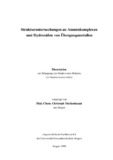Citation link:
https://nbn-resolving.org/urn:nbn:de:hbz:467-1547| DC Field | Value | Language |
|---|---|---|
| dc.contributor.author | Mockenhaupt, Christoph | - |
| dc.date.accessioned | 2019-09-02T09:54:58Z | - |
| dc.date.available | 2006-10-19T12:12:12Z | - |
| dc.date.available | 2019-09-02T09:54:58Z | - |
| dc.date.issued | 1999 | - |
| dc.description.abstract | Die Kristallstrukturen und IR-Spektren einige Ammoniakate, Co(OD) 2 und Mn 2 (OH) 3 Cl wurden im Hinblick auf ihr Wasserstoffbrückenbindungsverhalten untersucht. [Ni(NH 3 ) 6 ]SO 4 , [Cu(NH 3 ) 5 ]SO 4 und β-Mn 2 (OH) 3 Cl kristallisieren in der monoklinen Raumgruppe P2 1 /c mit a = 705,0(1), b = 1195,2(2), c = 1180,0(2) pm, β = 96,14(3)°, Z = 4, beziehungsweise in der orthorhombischen Raumgruppe Pnma mit a = 707,1(1), b = 1065,5(2), c = 1199,0(2) pm, Z = 4, und a = 650,02(2), b = 712,39(3), c = 953,10(3) pm, Z = 4. IR-Spektren von mikrokristallinen Zn(NH 3 ) 2 Br 2 und Ni(NH 3 ) 2 X 2 (X = Cl, Br) und ihre isotopen verdünnten Proben zeigen, daß die Wasserstoffbrückenbindungen in diesen Verbindungen stärker als in den entsprechenden oktaedrischen Komplexen sind. Die großen Unterschiede in den N⋅⋅⋅O-Abständen und den OD-Streckschwingungsfrequenzen für [Ni(NH 3 ) 6 ]SO 4 und [Cu(NH 3 ) 5 ]SO 4 weisen auf unterschiedlich starke Wasserstoffbrückenbindungen hin. Der vorhergesagte Brucit-Typ für Co(OD) 2 wurde bestätigt (P-3m1, a = 317,79(4), c = 464,2(1) pm und Z = 1). In der IR-Spektren der isotopen verdünnten Spektren wurden zwei anstatt nur einer erwarteten Bande beobachtet. Aufgrund der geringen Loslichkeit Brucit-Typ Hydroxiden führt der sehr langsame H/D-Austausch zu einer Mischung von voll und partiell deuterierten Spezies. In β-Mn 2 (OH) 3 Cl bilden die Wasserstoffatome mit ihren Positionen zwischen O und Cl Wasserstoffbrückenbindungen aus. Das Histogramm der O-H-Abstände in Brucit-Typ-Hydroxiden zeigt einen durchschnittlichen Abstand von 94 - 96 pm. Im Gegensatz zu den c Gitterkonstanten korrelieren die a Gitterkonstanten gut mit den mittleren M-O-Abständen. Die mittleren Metall-Sauerstoffabstände der ersten Koordinationssphäre korrelieren nicht mit Frequenzen der OH-Streckschwingungen. Zusammen mit der Rotverschiebung der OH-Valenzschwingungen bei zunehmendem Druck und den kurzen OH-Abständen weist alles auf schwache, dreifach gegabelte Wasserstoffbrücken in diesen Verbindungen hin. | de |
| dc.description.abstract | The crystal structures and IR-spectra of some ammoniakates, Co(OD) 2 , and Mn 2 (OH) 3 Cl have been determined with a view to study hydrogen bonding in these compounds. [Ni(NH 3 ) 6 ]SO 4 , [Cu(NH 3 ) 5 ]SO 4 and Mn 2 (OH) 3 Cl crystallize in the monoclinic space group P2 1 /c with a = 705.0(1), b = 1195.2(2), c = 1180.0(2) pm, β = 96.14(3)°, Z = 4, in the orthorhombic space group Pnma with a = 707.1(1), b = 1065.5(2), c = 1199.0(2) pm, Z = 4, and a = 650.02(2), b = 712.39(3), c = 953.10(3) pm, Z = 4, respectively. IR-spectra of microcrystalline Zn(NH 3 ) 2 Br 2 and Ni(NH 3 ) 2 X 2 (X = Cl, Br) and their isotopically diluted derivatives indicate that hydrogen bonds in these compounds are stronger than in the respective octahedral complexes. The broad range of N⋅⋅⋅O distances and OD stretching vibrations in [Ni(NH 3 ) 6 ]SO 4 and [Cu(NH 3 ) 5 ]SO 4 gives evidence for hydrogen bonds of very different strength. The predicted brucite type of Co(OD) 2 was confirmed (P-3m1, a = 317.79(4), c = 464.2(1) pm and Z = 1. In spectra of isotopically diluted samples two OD-stretching vibrations instead of the one expected were observed. The reason is found in the slow H/D exchange in these brucites with very low solubility, which leads to mixtures of fully and partially deuterated species. In Mn 2 (OH) 3 Cl both hydrogen atoms in positions directly between O and Cl take part in hydrogen bonding. A histogram of the O-H distances in brucite type hydroxides shows that the average distances are in the range 94-96 pm. Contrary to the lattice constants c the lattice constants a correlate well with the average O-H distances. The mean metal-oxygen distances of the first coordination sphere do not correlate withe the frequencies of the OH-stretching modes. Together with the red-shift of the OH valency modes with increasing pressures and the short O-H distances this is an indication for weak trifurcated hydrogen bridges in these compounds. | en |
| dc.identifier.uri | https://dspace.ub.uni-siegen.de/handle/ubsi/154 | - |
| dc.identifier.urn | urn:nbn:de:hbz:467-1547 | - |
| dc.language.iso | de | de |
| dc.rights.uri | https://dspace.ub.uni-siegen.de/static/license.txt | de |
| dc.subject.ddc | 540 Chemie | de |
| dc.subject.other | ammoniates | en |
| dc.subject.other | brucit type hydroxides | en |
| dc.subject.other | hydrogen bonds | en |
| dc.title | Strukturuntersuchungen an Amminkomplexen und Hydroxiden von Übergangsmetallen | de |
| dc.type | Doctoral Thesis | de |
| item.fulltext | With Fulltext | - |
| ubsi.date.accepted | 1999-09-22 | - |
| ubsi.publication.affiliation | Fachbereich 8, Chemie - Biologie | de |
| ubsi.subject.ghbs | UZS | - |
| ubsi.type.version | publishedVersion | de |
| Appears in Collections: | Hochschulschriften | |
Files in This Item:
| File | Description | Size | Format | |
|---|---|---|---|---|
| mockenhaupt.pdf | 2.6 MB | Adobe PDF |  View/Open |
This item is protected by original copyright |
Page view(s)
354
checked on Nov 25, 2024
Download(s)
198
checked on Nov 25, 2024
Google ScholarTM
Check
Items in DSpace are protected by copyright, with all rights reserved, unless otherwise indicated.

